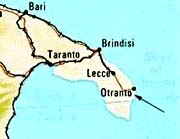The stygophilic copepods Metacyclops minutus and Nitocra spinipes, the water mite Soldanellonix monardi, and the mysid Spelaeomysis bottazzii, can be found in both the pools, apparently being less affected by temperature and salinity variations. In the deep "Cocito" (new submerged N-W way), still in course of exploration, to our great surprise, beside other known noteworthy stygobitic material (copepods, water mites, decapods), the amphipod Salentinella gracillima, the mysid Stygiomysis hydruntina, polichaete worms, previously unrecorded from this cave, and a new stygobitic sponge, Higginsia ciccaresei, have been collected.
 ISOPODS [Porcellio scaber, Halophiloscia hirsuta, Trichoniscus ruffoi (= T. fragilis?),
ISOPODS [Porcellio scaber, Halophiloscia hirsuta, Trichoniscus ruffoi (= T. fragilis?),  PSEUDOSCORPIONS (Chtonius stammeri)
PSEUDOSCORPIONS (Chtonius stammeri) GASTROPODS (Oxychilus cellarius austriacus)
GASTROPODS (Oxychilus cellarius austriacus) OLIGOCHAETES (Bucholzia appendiculata)
OLIGOCHAETES (Bucholzia appendiculata) COLLEMBOLS (Heteromurus nitidus, Neogastrura cavicola)
COLLEMBOLS (Heteromurus nitidus, Neogastrura cavicola) LEPIDOPTERA (Hypena obsitalis)
LEPIDOPTERA (Hypena obsitalis) COLEOPTERA (Gnathonus pygidialis)
COLEOPTERA (Gnathonus pygidialis) ORTHOPTERA (Troglophilus andreini var. hydruntinus)
ORTHOPTERA (Troglophilus andreini var. hydruntinus) DIPTERA (Culex pipiens, Nycteribosca kollari, Nycteribia sp., Dolicopodidae sp.)
DIPTERA (Culex pipiens, Nycteribosca kollari, Nycteribia sp., Dolicopodidae sp.) MIRIAPODS (Lysiopethalum sicanum, Cryptos hortensis, Lithobius picens peregrinus, Trachidesmus simoni
MIRIAPODS (Lysiopethalum sicanum, Cryptos hortensis, Lithobius picens peregrinus, Trachidesmus simoni  SPIDERS (Harpactes strandi, Meta marianae, Meta segmentata segmentata, Pholcus phalangioides,
SPIDERS (Harpactes strandi, Meta marianae, Meta segmentata segmentata, Pholcus phalangioides, MITES (Macrocheles penicilliger, Macrocheles minervae, Bdellonyssus arcuatus, Rhizoglyphus echinopus,
MITES (Macrocheles penicilliger, Macrocheles minervae, Bdellonyssus arcuatus, Rhizoglyphus echinopus,  CHIROPTERANS (Myotis capaccini, Rhinolophus euryale, Miniopteris schreibersi)
CHIROPTERANS (Myotis capaccini, Rhinolophus euryale, Miniopteris schreibersi)
[click on images to enlarge]
BOTTAZZI.F. 1924. La grotta Zinzulusa in Terra d'Otranto e il ritrovamento in essa di Typhlocaris. Atti Soc.it. Progr. Sc., 12a Riun. 1923, Catania, II.
BOTTI U. 1871. Le caverne del Capo di Leuca. Tip. salentina, Lecce, 1871.
CAROLI E. 1923. Di una specie italiana di Typhlocaris (T. salentina n.sp.) con osservazioni morfologiche e biologiche sul genere. Boll. Soc. Nat. Napoli, 35: 265-267.
CAROLI E. 1924. Su di un misidaceo cavernicolo (Spelaeomysis bottazzii n.gen. n.sp.) di Terra d'Otranto. Rend. Acc. Naz. Lincei, 33, ser.5:512-513.
CAROLI E. 1937. Stygiomysis hydruntina n. gen., n.sp., Misidaceo cavernicolo di terra d'Otranto, rappresentante di una nuova famiglia. Nota preliminare. Boll. Zool., 8: 219-227.
DE LORENTIIS P. 1924. Grotte del Salento: La Zinzulusa. "Le Vie d'Italia", n.7, Milano p.785.
LAZZARI A. 1966. La Grotta Zinzulusa presso Castro prov. di Lecce (Osservazioni geo-morfologiche con notizie storico-bibliografiche e due appendici).Ann. Ist. Sup. Sc. e Lett. S. Chiara, Napoli:1-63
PARENZAN P. 1958. Il mistero della Zinzulusa svelato. Storia e biologia dell'interessante grotta di Castro Marina in terra d'Otranto (Puglie). "Studia Spelaeologica", vol. 3, Napoli.
PARENZAN P. 1981. Puglia Marittima. Aspetti geologici e biologia marina.Congedo Ed., I-II, pp.688
PASA A: 1953. Appunti geologici per la paleogeografia delle Puglie. Mem. Biogeogr. Adriatica, 2: 175-286
PESCE G.L. 1983. Contributo alla conoscenza degli arpacticoidi delle acque sotterranee della regione pugliese (Crustacea:Copepoda). Thalassia Salentina, 12-13:62-82
PESCE G.L. 1997. La grotta Zinzulusa, scrigno di antiche meraviglie. Magazine Caripuglia, Bari: 60-63.
PESCE G.L., G. FUSACCHIA, D. MAGGI & P. TETE'. 1978. Ricerche faunistiche in acque freatiche del Salento (Contributo alla conoscenza della fauna delle acque sotterranee dell'Italia centro-meridionale:V). "Thalassia Salentina", Taranto, 8:51.
PESCE G.L. & D.P. GALASSI. 1987. Discovery of the first representative of the genus Neocyclops Gurney (Copepoda, Halicyclopinae) in groundwater of Italy. Crustaceana, 52 (2):209-212.
PESCE G.L., D. MAGGI & P. TETE. 1985. Stato attuale delle conoscenze sui Ciclopidi delle acque sotterranee della Puglia (Crustacea: Copepoda):. Carsia Apula, 1: 71-92.
RUFFO S: 1949. Monodella stygicola n.gen. n. sp. nuovo crostaceo Termosbenaceo delle acque sotterranee della Penisola Salentina. Arch. Zool. It., 34:31-48.
RUFFO S. 1949. Sur Monodella stygicola Ruffo des eaux souterraines de l'Italie méridionale, deuxieme espéce connue de l'ordre des Thermosbénacés. Hydrobiologia. II: 56-63.
RUFFO S. 1958. Le attuali conoscenze sulla fauna cavernicola della regione pugliese. Mem.Biogeogr. Adriatica, 3: 1-143.
 |
Only guided visiting tours from 9.30 a.m to 6,30 p.m. (July 15 - September 15) and from 10.30 a.m to 4.30 p.m. (September 16 -July 14). Itinerary.
I° Incontro di Studi su:
IL CARSISMO NELL' AREA MEDITERRANEA
(Geologia-Paleogeografia-Biologia)
L'Italia Meridionale con particolare riferimento alla Penisola Salentina
Castro Marina (Lecce) 1-2 Settembre 1997
Thanks are due to N. Ciccarese, M.M. Camassa and V. Fersini
for their assistance and collaboration.[Home Page] [Feedback] [Previous Page]